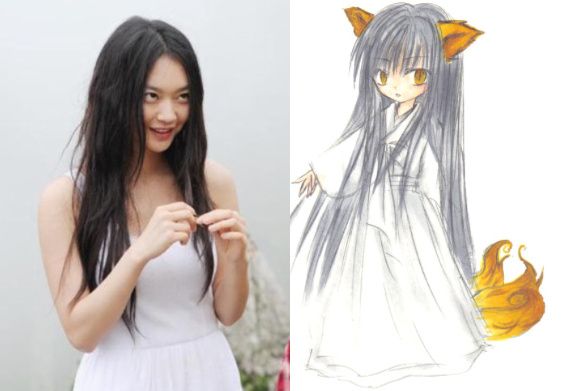
A gumiho [구미호] is a nine-tailed fox, a legendary creature with origins in ancient Chinese myths dating back centuries. There are versions of the figure in Chinese and Japanese folklore, although each differs slightly. The Chinese huli jing and the Japanese kitsune have more ambiguous moral compasses, in that they can be both good and bad, and are not necessarily out to get everyone. The Korean gumiho, on the other hand, is almost always a malignant figure, a carnivore who feasts on human flesh.

The Korean gumiho is traditionally female. Some can hide their gumiho features, while other myths indicate that they can’t fully transform (ie. a fox-like face or set of ears, or the tell-tale nine tails). Either way there is usually at least one physical trait that will prove their true gumiho form, or a magical way to force them to reveal this form.
Much like werewolves or vampires in Western lore, there are always variations on the myth depending on the liberties that each story takes with the legend. Some tales say that if a gumiho abstains from killing and eating humans for a thousand days, it can become human. Others, like the drama Gumiho: Tale of the Fox’s Child, say that a gumiho can become human if the man who sees her true nature keeps it a secret for ten years. Regardless of each story’s own rules, a few things are always consistent: a gumiho is always a fox, a woman, a shape-shifter, and a carnivore.

In Korea, the fox has a second cultural implication—that of sexual cunning. The word for fox, yeo-woo [여우] is actually what Koreans call a woman who is, for lack of a better translation, a vixen, a siren, or a sly man-eater. There is a similar English equivalent in the phrase “you sly fox,” although in Korean it’s gender-specific (only women get called yeo-woo), and has a much more predatory “there-you-go-using-your-feminine-wiles-to-trick-me” kind of meaning behind it. Women who use any sort of feminine charm in an overt way, or women who are overtly sexualized (as in, asserting and brandishing their sexuality in a bold way), get called “yeo-woo.” Interestingly, the word for “actress” [여배우] is the same in its shortened form: [여우].


WTF, Korean folktales?
The concept of female sexuality as dangerous is nothing new to folklore, for sure. But it’s not a stretch to say that both the gumiho figure and the use of “yeo-woo” are quite prevalent in modern culture and its fiction. Most people may gloss over the fact that the gumiho myth is a story designed to uphold patriarchy. But that’s what makes such a legend so cunning in its own right.



All this isn’t to say that female writers couldn’t take ownership of such a legend and reclaim it. I think that’s the only way to take it out of this territory and blast all these old versions away with something empowered. Do I think that’s what the Hong sisters’ goal is? Not outright. And I’m definitely not going to be watching that rom-com for its stellar commentary on gender politics. What I will be doing is looking forward to the reversal, the woman-on-top dynamic of the beta male dating a powerful gumiho, and crossing my fingers for a step in the right direction.




No comments:
Post a Comment
Ask me anything , i will reply as soon as possible . xoxo